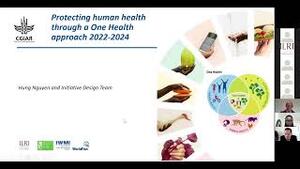
Epidemiology of antimicrobial-resistant Escherichia coli carriage in sympatric humans and livestock in a rapidly urbanizing city
Abstract
There are substantial limitations in our understanding of the distribution of antimicrobial resistance (AMR) in humans and livestock in developing countries. Here, we present the results of an epidemiological study examining patterns of AMR in Escherichia coli isolates circulating in sympatric human (n=321) and livestock (n=633) samples from 99 households across Nairobi, Kenya. E. coli isolates were tested for susceptibility to 13 antimicrobial drugs representing 9 antibiotic classes. We detected high rates of AMR, with 47.6% and 21.1% of isolates displaying resistance to ≥ 3 and ≥5 antibiotic classes respectively. Human isolates showed higher levels of resistance to sulfonamides, trimethoprim, aminoglycosides and penicillins compared to livestock (p<0.01), while poultry isolates were more resistant to tetracyclines (p=0.01) compared to humans. The most common co-resistant phenotype observed was to tetracyclines, streptomycin and trimethoprim (30.5%). At the household level, AMR carriage in humans was associated with human density (p<0.01) and the presence of livestock manure (p=0.03), but livestock keeping on its own had no influence on human AMR carriage (p>0.05). Our findings revealed a high prevalence of AMR E. coli circulating in healthy humans and livestock in Nairobi, with no evidence to suggest that keeping livestock, when treated as a single risk factor significantly contributed to the burden of AMR in humans, although the presence of livestock waste was significant. These results provide an understanding of the broader epidemiology of AMR in complex, and interconnected urban environments.
Citation
Muloi, D., Kiiru, J., Ward, M.J., Hassell, J.M., Bettridge, J.M., Robinson, T.P., Bunnik, B.A.D. van, Chase-Topping, M., Robertson, G., Pedersen, A.B., Fèvre, E.M., Woolhouse, M.E.J., Kang'ethe, E.K. and Kariuki, S. 2019. Epidemiology of antimicrobial-resistant Escherichia coli carriage in sympatric humans and livestock in a rapidly urbanizing city. International Journal of Antimicrobial Agents 54(5): 531–537.










